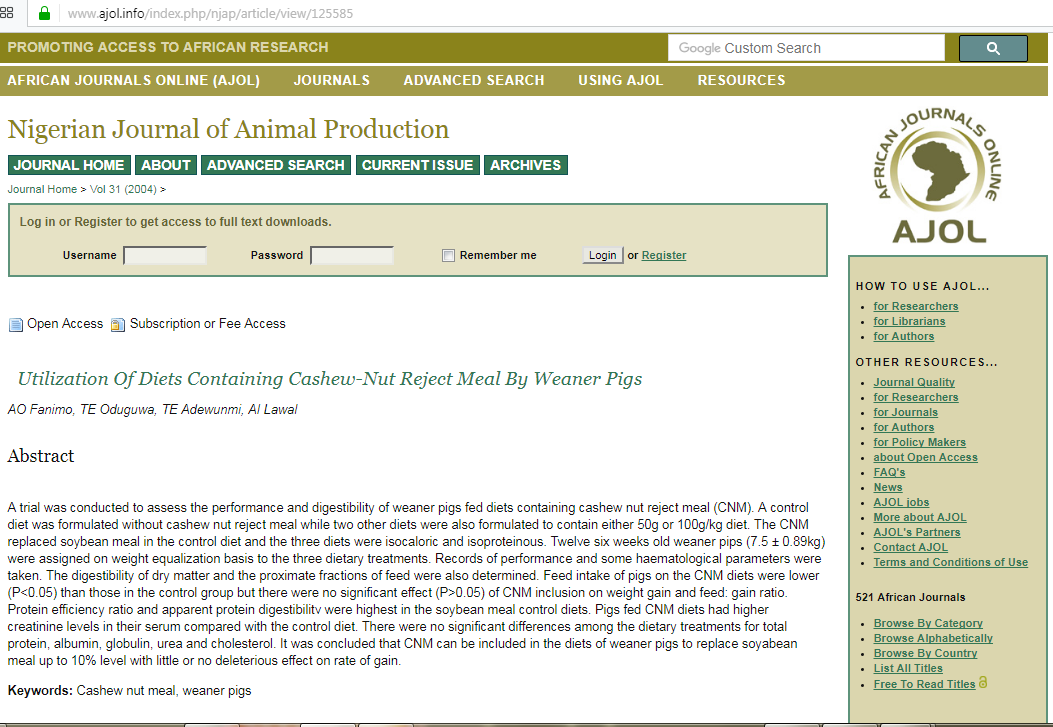This post is based on excerpts from an email message I sent to a Pig Farm CEO I’m working with to develop and implement ideas and strategies to boost farm output and profitability.
The message features two previews, with links to research study reports – that I’d been reviewing based on his expressed interest in using Cashew as a cheaper alternative feed ingredient (to Soyabean) in formulating rations for his pigs.
I ended it by pointing out 4 crucial factors to be carefully considered before adopting a “cheaper” alternative feed ingredient (like Cashew) to replace a conventional or standard feed ingredient like Soya bean]
Below are the two report previews ending with URLs…
[No. 1] Finishing swine fed cashew bagasse bran
ABSTRACTThe purpose of this study was to evaluate the digestibility of cashew bagasse bran as well as the performance of swine fed diets with different levels of inclusion of this by-product and their economic viability.
In the digestibility trial, ten crossbred barrows weighing 60±6.86 kg were housed in metabolic cages. Five received standard feed and five received test feed with 300 g kg−1 cashew bagasse bran included.
For the performance and economic viability study, forty crossbred pigs weighing 60±5.24 kg were allotted in a randomized block design with five treatments (0, 75, 150, 225, and 300 g kg−1 inclusion of cashew bagasse bran) and four replications.
Daily feed intake, daily gain, feed conversion, partial gross income with and without allowance index, and partial net income with and without allowance index were evaluated. Data were subjected to analysis of variance and regression analysis.
The treatment with 75 g kg−1 cashew bagasse bran provided the best results. Cashew bagasse bran can be included in the diet of finishing pigs up to the level of 300 g kg−1 without adversely affecting animal performance.
Key Words: alternative feed; crude fiber; pig; pseudo cashew
http://www.scielo.br/scielo.php?script=sci_arttext&pid=S1516-35982016000500236
[No. 2] Utilization Of Diets Containing Cashew-Nut Reject Meal By Weaner Pigs
AO Fanimo, TE Oduguwa, TE Adewunmi, AI LawalAbstract
A trial was conducted to assess the performance and digestibility of weaner pigs fed diets containing cashew nut reject meal (CNM). A control diet was formulated without cashew nut reject meal while two other diets were also formulated to contain either 50g or 100g/kg diet. The CNM replaced soybean meal in the control diet and the three diets were isocaloric and isoproteinous.
Twelve six weeks old weaner pips (7.5 ± 0.89kg) were assigned on weight equalization basis to the three dietary treatments. Records of performance and some haematological parameters were taken.
The digestibility of dry matter and the proximate fractions of feed were also determined. Feed intake of pigs on the CNM diets were lower (P0.05) of CNM inclusion on weight gain and feed: gain ratio.
Protein efficiency ratio and apparent protein digestibilitv were highest in the soybean meal control diets. Pigs fed CNM diets had higher creatinine levels in their serum compared with the control diet. There were no significant differences among the dietary treatments for total protein, albumin, globulin, urea and cholesterol.
It was concluded that CNM can be included in the diets of weaner pigs to replace soyabean meal up to 10% level with little or no deleterious effect on rate of gain.
Keywords: Cashew nut meal, weaner pigs
https://www.ajol.info/index.php/njap/article/view/125585
NB; This 2nd report seems to be for sale, as you get taken to a subscription page when you click the link to view the full report.
What I will say however, is that the abstract is enough to get an idea of how the findings with regards to the usefulness of Cashew.
Having said the above (i.e. that Cashew is a good alternative to REPLACE expensive Soya Bean meal in rations fed to pigs), there are other factors to consider in deciding how to use this alternative feed ingredient – and I highlyight 4 key ones below…
1. AVAILABILITY– How readily can you get it to purchase, in the volumes and at the quality you NEED it to be for optimal feeding performance to happen for your pigs?
2. PRICE & PRICE STABILITY: What is the current price like, compared to Soya Bean? How significant is the difference between their prices? Also does it fluctuate? If YES, how much does that happen, and is there a pattern? PLUS can one plan successfully to make productive use of it despite such changes?
3. STORAGE: How well does it keep when put in storage? Does it have any serious sensitivity to the kind of storage conditions I saw on your farm e.g. exposure to moisture and prolonged storage before use?
4. RAW FORM: What form does the Cashew that is available come in? It is important to note that the research papers reviewed above referred to Cashew that had been processed into a specific physical form.
You will need to establish what form the cashew that will be available to YOUR farm will come in. This is so you can be sure what kind of handling it will require – otherwise you may not get the same feeding performance from using it, that the researchers suggest is possible.
So, you need to find out if, for instance, it will come as Cashew Nut Meal (CNM) or some other form.
If NO< there may be a requirement for you to do the necessary processing (e.g. grinding the nut) at your end before using it to feed your animals. If that need arises, do you have the required tools or equipment to do it right?
Improvising is never a good way to handle processing of ingredients for animal feeding, because it can directly affect the ability of the animals to optimally utilize it for growth and development.
Final Words
The way I see it, considering the VOLUME of this ingredient (Cashew) your pigs will be likely to require on a daily basis, if it is to be used, it may not be possible to get reliable access to it on a consistent basis.
But that’s just my thinking based on my current awareness “availability” of this particular item…
The realities that you eventually encounter by virtue of your farm’s location and efforts you invest, could result in more favorable outcomes in that regard.
So, goodluck to you!
Source: ExcelVB

